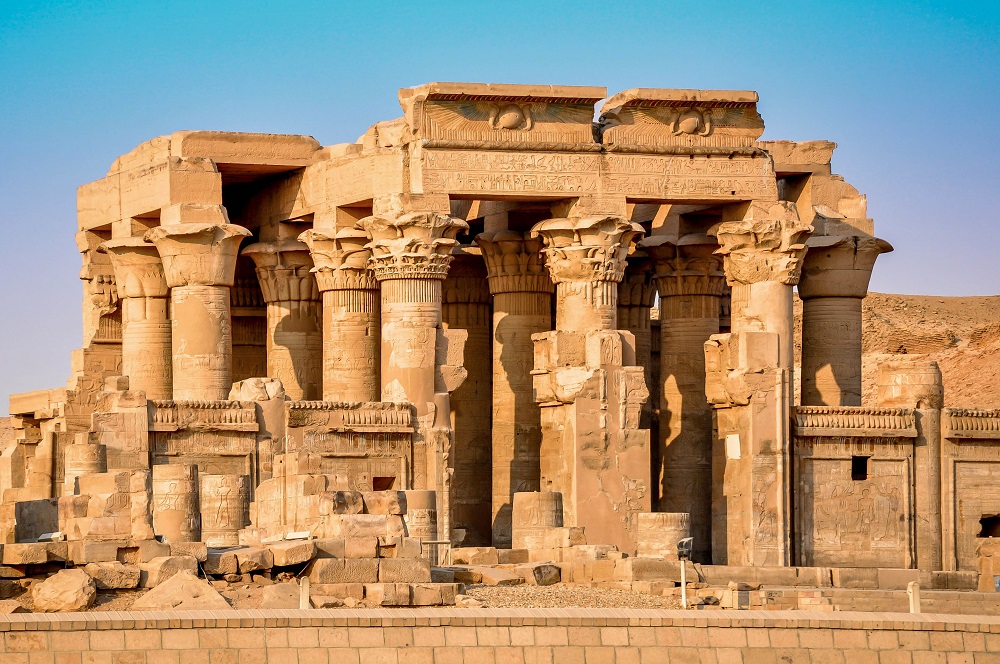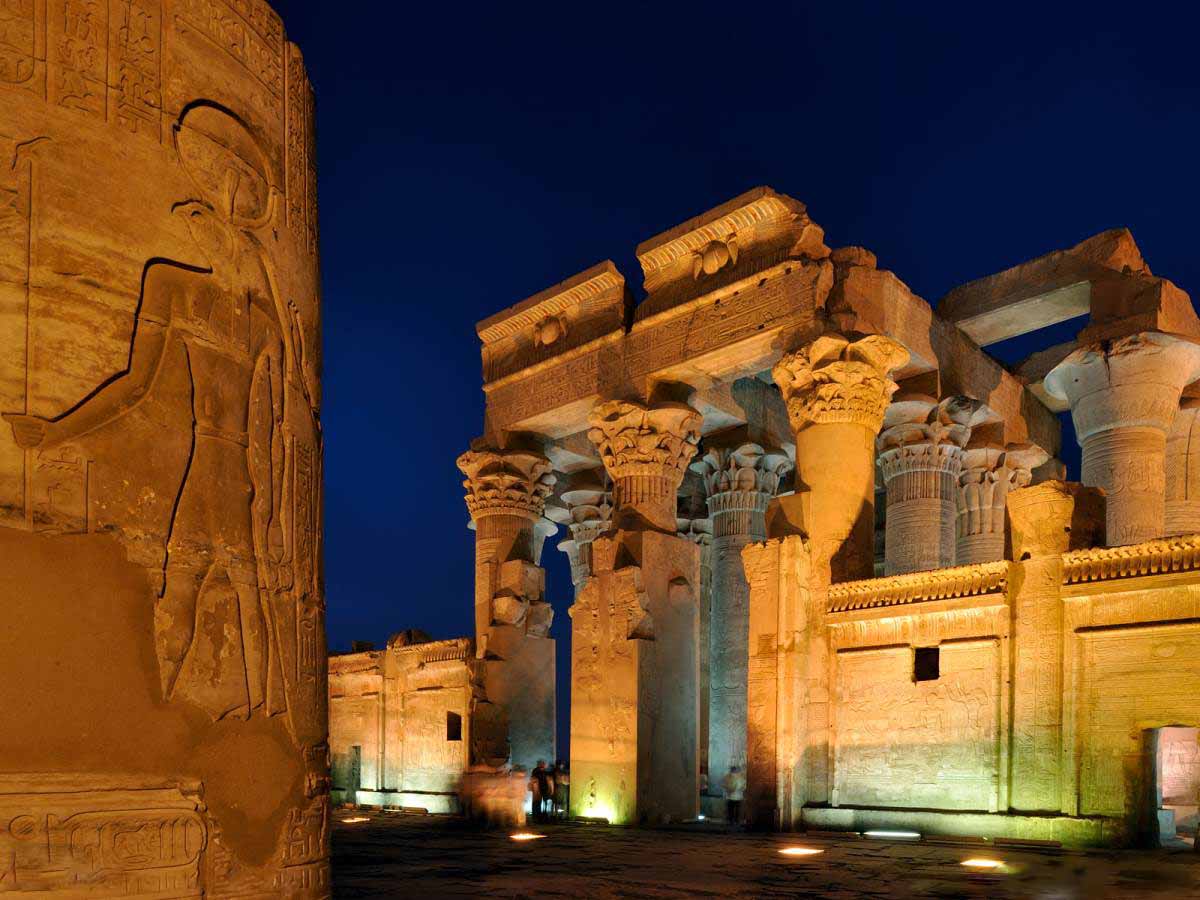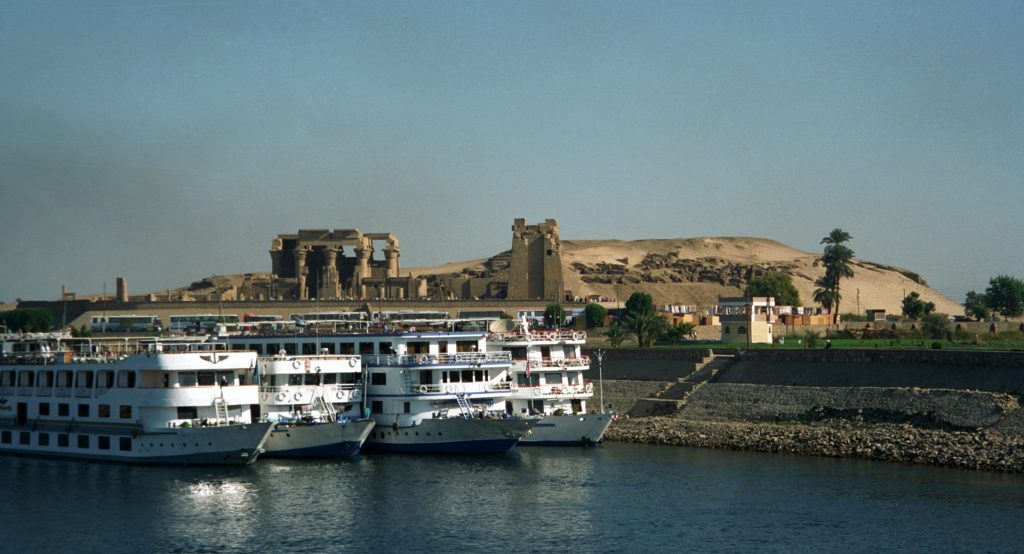Kom ombo
ln early dynastic times Kom Ombo stood at the northern end of the border province of Aswan. Here is the physical division between the limestone belt of Egypt and the sandstone belt of Nubia, and here is where a large part of the population of Lower Nubia are now relocated.
It is also the site ofthe elegant double temple of Horus the hawk-god, and Sobek the crocodile-god.
Of the early history of Kom Ombo we know little.

lt was, however, undoubtedly of strategic importance, as it commanded both a great bend in the Nile and the caravan-routes to Nubia and the oases of the Westem Desert.
Moreover, a road led from Kom Ombo to the gold mines of the Eastern Desert, the largest in Egypt.
According to a very ancient tradition Gebel Silsila Chill of the chain’), a range of hills north of Kom Ombo, once blocked river traffic from the south.
It was said that there a great chain stretched across the river.
Holders of the tradition even today point to two odd-shaped rocks -that approach the river as the very posts to which a real chain was once secured! The range may have been the northernmost point at which early Nubian settlement in Egypt occurred.
elephants during the short time when the Ptolemies thought they might use elephants as mounts in the field of battle.
Later, the town succumbed to a fire, which hastened its decline, Fortunately the temple survived.
It still remains a well-preserved exam ple of`Ptolemaic architecture.

In 1869, Mariette wrote that the temple was doomed to be eventually consumed by the Nile. Already the current had swallowed up one half of the great southern pylon.
The destruction of the temple was checked in 1893 when a stone embankment was erected, and this was recently reinforced by the Egyptian Antiquities Organization, which noted that salt has eroded 20 percent of the temple.
The ‘double temple’ is built on a traditional plan with entrance pylon, forecourt, hypostyle hall, and surrounding chambers leading to the sanctuary, where the sacred statue of the deity was housed; but instead of a single temple, there are two side by side.
An invisible division down the middle of thetemple separates two doorways, corresponding forecourts, and colonnaded halls, leading to corresponding sanctuaries.
One is dedicated to Horus, the other to Sobek.
In addition to the main temple there is a Birth House (which has lost its western half
to the river), and a shrine dedicated to Hathor south of the courtyard.
The shrine was used to store mummified crocodiles from the nearby necropolis. Korn Gmbo Temple faces south. The left-hand tower of the entrance pylon is mostly destroyed.
On the better-preserved right-hand tower, a procession is led by the Roman emperor Domitian (lower register), with Hapi the Nile-god and other deities hearing offerings. ln the upper register Domitian ieaves the palace, led by a priest who burns incense and is accompanied by other priests, who bear the tribal standards related to the triad headed by Sohek, with Hathor as his wife and ihiiorisu as their son. The court (1) is spacious.
The fine proportions ofthe temple are clearly apparent. It has eight columns on each side of the central axis, only the drums of which remain, and an altar near the center.
From the vantage of this court one can look north- ward through each of the double doors toward the rear of’ the temple.
The eye passes from doorway to doorway through to the sanctuaries. The court is decorated with scenes of the pharaoh making offerings to the deities.
The hypo style hall (2) has ten columns supporting a roof, the underside of which is decorated with flying vultures, their wings spread over the two main aisles, and astrological figures beneath the architrave.
The columns have elaborate palm-frond and flower capitals; the wall reliefs are distinct.
They feature all the Ptolemaic rulers who contributed to the decoration of the temple: Ptolemy VI, Ptolemy IX, and Ptolemy XII.
It is noticeable that the reliefs on the inside of the temple, which date to Ptolemaic times, are much finer than those of”the outer walls, crude sunken reliefs that date to later Roman times.
Among the best of the Ptolemaic reliefs is a scene in the hypostyle hall (a) that shows Ptolemy XII, in the presence of Horus, receiving the symbol of Life from Isis and Nut, the sky~goddess. The goddesses protect the pharaoh, while Thoth and Horus Son of`Isis stand behind him.
The corresponding scene at
b (not as carefully worked or as well preserved) shows the king crowned by the vulture-goddess of the predynastic capital of Upper Egypt, and the serpent-goddess ofthe predynastic capital of Lower Egypt. V’ ‘ P ?’ ` Passing through one of two doorways we enter a smaller hypostyle hall, which is also ten-olurnned but far less impos- ing.
The roof has almost entirely vanished,
and also much of the Some fine Quality relief work in the temple of Kom Ombo walls.
Open to the sky, the hall has been robbed of much of its mystery. Some of the reliefs, however, are in good condition.
Along the comice of the Horus doorway leading to the first ante-chamber is an interesting inscription that tells of the part played by the Greek garrison ofthe district in the erection of the temple.
It reads: In honour of King Ptolemy and Queen Cleopatra, his sister, the god-like Philometores and their children, the infantry, cavalry, and the troops stationed in the Ombite district (erected) this temple to Horoeris, the great god, Apollo, and the gods worshipped with him in the same temple, inconsequence of the good-will of these gods to them.
(Baikie, Egyptian Antiquities in the Nile Valley, p.692) The three antechambers that lie to the rear of the small hypostyle hall are all roofless, and the west wall has entirely disappeared.
Some of the reliefs flanking Sobek’s doorway leading to the second antechamber are particularly noteworthy.
To the right, Ptolemy VI Philometor
makes an offering to Horus (both headless), and at C and d the king performs a ceremony connected with the founding ofthe temple.
A related scene on the Horus side of the temple (e) shows the goddess Safkhet engaged with Horus in pegging out the limits of the new temple.
Unfortunately the scene is badly damaged. The second antechamber is largely in ruin, but in the third is an interesting scene to the rear, between the two sanctuaries(f).
The lowest register shows figures of Hapi the Nile-god supplying water to the North and the South, with offerings.
Above is a scene with Ptolemy VI wearing the double crown and a long white robe, accompanied by his queen, Cleopatra.
They are also accompanied by deities, one of which is Khonsu-Hor, who marks off the mimbef of the king’s jubilees on a notched palm-branch. Unfortunately, the two sanctuaries (3) are in a poor state ot preservation.
Horus’s granite pedestal once stood to the east, and Sobek’s to the west.
Between them is a hidden corridor, cut through the thickness of the wall, a secret place approached only from a chamber in the rear.
A stone on the floor would be raised, admitting a priest to the passage below ground level.
One assumes he played a part in the oracular power attributed to the two deities, answering questions put to them.
The entire inner corridor is decorated with reliefs, as is the outer corridor.
Many are in an excellent state of preservation, but unfortunately they are unfinished.
To the rear of the sanctuary are seven chambers; the central one has a stairway leading to the roof.
This unique double temple enjoys an ideal location at the edge of the Nile, and for that reason it is perhaps, after the temples of Philae, Egypt’s most picturesque monument.
It suffered slight damage during the earthquake of October 1992, but the two blocks that collapsed from the roof of the hypo style hall have been replaced and some cracks in the masonry repaired.
The Birth House stands on the terrace close to the river.
The reliefs were an attempt, during this late period in ancient history, to imitate some ofthe traditional scenes of hunting and fishing in the papyrus thickets.
They are not very successful.
An interesting relief on the outer wall, to the rear, shows sacred mother and child: Isis suckling Horus.
In the unfinished chapel of Hathor are some mummified remains of sacred crocodiles.


